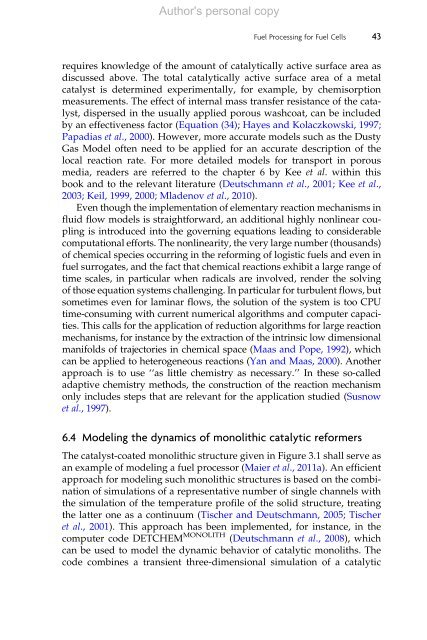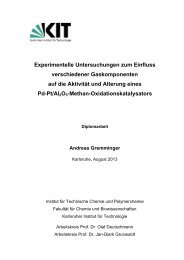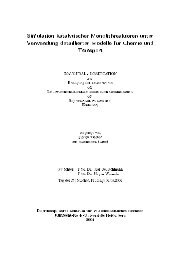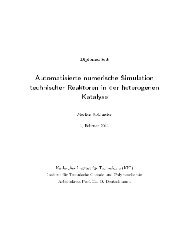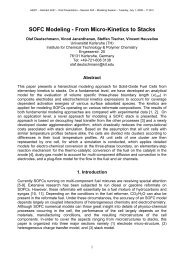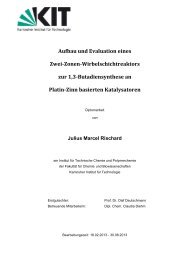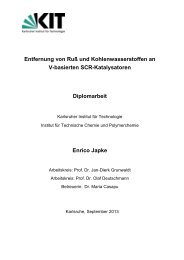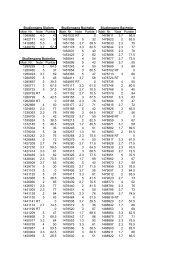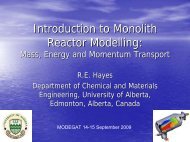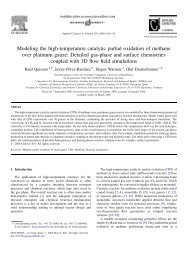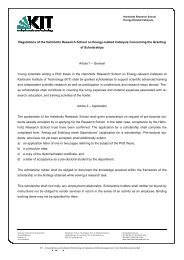Fuel Processing for Fuel Cells - Institut für Technische Chemie und ...
Fuel Processing for Fuel Cells - Institut für Technische Chemie und ...
Fuel Processing for Fuel Cells - Institut für Technische Chemie und ...
Create successful ePaper yourself
Turn your PDF publications into a flip-book with our unique Google optimized e-Paper software.
Author's personal copy<br />
<strong>Fuel</strong> <strong>Processing</strong> <strong>for</strong> <strong>Fuel</strong> <strong>Cells</strong> 43<br />
requires knowledge of the amount of catalytically active surface area as<br />
discussed above. The total catalytically active surface area of a metal<br />
catalyst is determined experimentally, <strong>for</strong> example, by chemisorption<br />
measurements. The effect of internal mass transfer resistance of the catalyst,<br />
dispersed in the usually applied porous washcoat, can be included<br />
by an effectiveness factor (Equation (34); Hayes and Kolaczkowski, 1997;<br />
Papadias et al., 2000). However, more accurate models such as the Dusty<br />
Gas Model often need to be applied <strong>for</strong> an accurate description of the<br />
local reaction rate. For more detailed models <strong>for</strong> transport in porous<br />
media, readers are referred to the chapter 6 by Kee et al. within this<br />
book and to the relevant literature (Deutschmann et al., 2001; Kee et al.,<br />
2003; Keil, 1999, 2000; Mladenov et al., 2010).<br />
Even though the implementation of elementary reaction mechanisms in<br />
fluid flow models is straight<strong>for</strong>ward, an additional highly nonlinear coupling<br />
is introduced into the governing equations leading to considerable<br />
computational ef<strong>for</strong>ts. The nonlinearity, the very large number (thousands)<br />
of chemical species occurring in the re<strong>for</strong>ming of logistic fuels and even in<br />
fuel surrogates, and the fact that chemical reactions exhibit a large range of<br />
time scales, in particular when radicals are involved, render the solving<br />
of those equation systems challenging. In particular <strong>for</strong> turbulent flows, but<br />
sometimes even <strong>for</strong> laminar flows, the solution of the system is too CPU<br />
time-consuming with current numerical algorithms and computer capacities.<br />
This calls <strong>for</strong> the application of reduction algorithms <strong>for</strong> large reaction<br />
mechanisms, <strong>for</strong> instance by the extraction of the intrinsic low dimensional<br />
manifolds of trajectories in chemical space (Maas and Pope, 1992), which<br />
can be applied to heterogeneous reactions (Yan and Maas, 2000). Another<br />
approach is to use ‘‘as little chemistry as necessary.’’ In these so-called<br />
adaptive chemistry methods, the construction of the reaction mechanism<br />
only includes steps that are relevant <strong>for</strong> the application studied (Susnow<br />
et al., 1997).<br />
6.4 Modeling the dynamics of monolithic catalytic re<strong>for</strong>mers<br />
The catalyst-coated monolithic structure given in Figure 3.1 shall serve as<br />
an example of modeling a fuel processor (Maier et al., 2011a). An efficient<br />
approach <strong>for</strong> modeling such monolithic structures is based on the combination<br />
of simulations of a representative number of single channels with<br />
the simulation of the temperature profile of the solid structure, treating<br />
the latter one as a continuum (Tischer and Deutschmann, 2005; Tischer<br />
et al., 2001). This approach has been implemented, <strong>for</strong> instance, in the<br />
computer code DETCHEM MONOLITH (Deutschmann et al., 2008), which<br />
can be used to model the dynamic behavior of catalytic monoliths. The<br />
code combines a transient three-dimensional simulation of a catalytic


